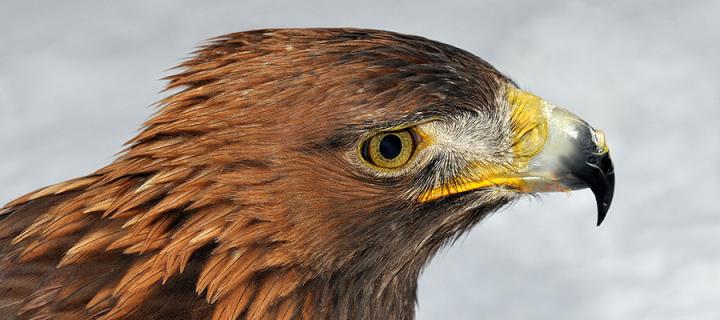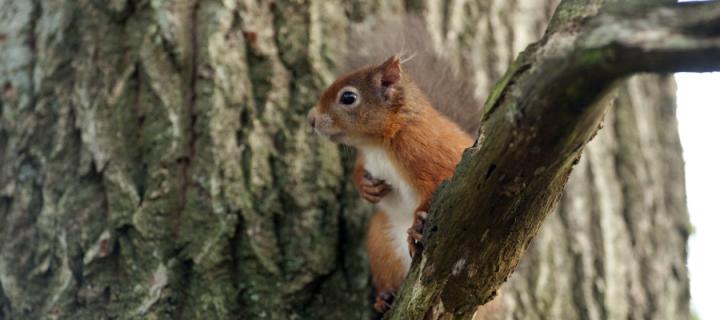Dr Rob Ogden on conservation genetics
How genetic research helps wildlife conservation, the importance of involving communities and his dream of being a football player.
Dr Rob Ogden is the Director of Conservation Science, encompassing Conservation Genetics at The Roslin Institute and Conservation Medicine at the Royal (Dick) School of Veterinary Studies at the University of Edinburgh.
In this interview, Rob told Maggie Szymanska about how he specialises in applied conservation genetics and wildlife DNA forensics, principally using genetic data to inform conservation management of wildlife and to support wildlife crime investigations.
Could you describe your work in a nutshell?

Our conservation genetics team focuses on a variety of wildlife projects, spanning marine, terrestrial and avian species. We currently know much less about the genomes of wildlife species compared to domesticated species.
Here at The Roslin Institute, we can use our knowledge of the genomes of pigs, cattle and chickens to learn more about wild animals such as wild boar, oryx and golden eagles, by looking at correlations and associations with their better-studied domesticated relatives.
We can also learn a lot about the genetics of our domesticated animals by investigating their wild counterparts. Understanding more about where breeds came from and the diversity present in the wild helps to inform other scientists focusing on domestic animal production.
So your team focuses on animals different from the majority of research happening at The Roslin Institute?
Yes, that’s true. A lot of the research being done here at The Roslin Institute focuses on farmed animals, in particular pigs, sheep, chickens and cows. Although rare breeds are a conservation issue, our projects tend to focus on wildlife populations.
The Roslin Institute also has a large focus on marine aquaculture and I do quite a lot of work on marine genetics and marine conservation so there are parallels here too. For example we use genetic analysis of fish species to look at issues of traceability and illegal fishing. There are also many interesting biological questions about what a natural fish population looks like in the sea.
Why did you decide to work here?
Normally, someone studying wildlife genetics would probably be in a biological sciences department. However, since we apply our research to conservation my team focuses on applied science. Both The Roslin Institute and the Royal (Dick) School of Veterinary Studies have a strong focus on application: applying good research to animal production and health. In a biology department the science tends to be less directly applied and more focused on big-picture fundamental questions.
As a wildlife geneticist the importance placed on applied science here at the Institute appealed to me. Our research always has a purpose, a real-world question we are trying to answer, so we are always focused on the impact of our work.
Could you briefly describe one of your projects?
One of the main projects our team have been working on is studying golden eagles. We have recently sequenced the genome of the Scottish golden eagle and we’re currently investigating how populations vary genetically and how this information can inform golden eagle management in the wild.

Golden eagles are fascinating, they are a global species, living all around the northern hemisphere. So, for example, we can compare golden eagles in Scotland and golden eagles in places like Japan and discover how distinct they are. This can be important when looking at reintroducing birds, or translocating them between regions.
Aside from conservation genetics, part of our conservation science group also looks at the populations of golden eagles in the north of Scotland from a conservation medicine perspective, trying to establish biomarkers that allow us to correlate the health of the birds with environmental conditions and their underlying biology.
Our conservation medicine group are also doing some really interesting work on red squirrels and leprosy. We are looking at various populations in the UK to investigating differences in disease susceptibility.
How do you see the future of your research field?
What I would like to see happen is conservation genetic management being taken to the next level in terms of exploiting genome wide data for wildlife species. Conservation genetics has been around for about twenty years and we’ve traditionally used quite simple genetic techniques. These inform us a little bit about diversity, such as telling us about the genetic differences between populations or species or individuals. However, we don’t really know what the differences mean.
With genomics we can start to understand not just what genetic variation is present but also what it actually relates to. Wildlife research is currently at the beginning of this phase and we can learn a lot from the livestock genomics community, who are exploiting variation across the genome to increase productivity or disease-resistance.
For wildlife conservation, some of the key questions are: How are populations adapted locally? How are species likely to respond to climate change? How can we best manage conservation breeding programmes?
There are a lot of questions in terms of genomics and understanding genomic function but we’re still quite a long way away from actually answering most of them.
What’s your favourite story or experience?
Oh I don’t know, there have been so many! I travel a lot – I’ve been to fifteen countries this year already so there is quite a lot happening.
Being involved in a large animal reintroduction is pretty cool. I have worked on the reintroduction of scimitar horned oryx from the UAE into Chad from the beginning of the project. It’s taken me to various parts of the Middle East where hundreds of oryx were being collected together to be flown to Chad for release.
The whole project brought together scientists working across a broad range of subjects to support the reintroduction – and to see it work has been amazing! We now have oryx breeding in the wild for the first time in 40 years. It is early days but it’s going well.
When were the oryx reintroduced?
It was quite recently actually, the first were flown out in February 2016 and moved into soft release enclosures. The oryx were fully reintroduced around late summer 2016. The goal is to increase the population up to 500 individuals over a five year period. They all have satellite tags so we can monitor where they go individually, within a National Park in Chad. Alongside the technical challenges community engagement has been crucial to the project’s success. As the oryx disappeared from Chad in the 1970s, nobody under the age of 40 has ever seen one before, so it was very important to raise local awareness, encourage their involvement and get the oryx back into their native range before they were forgotten.
Why did you decide to become a scientist?
Various reasons, firstly, my dad was a scientist. When I finished my degree I travelled for a couple of years, not committing to anything, but as I was always fascinated by biology I decided to do a PhD in evolutionary genetics. This was really interesting and a lot of fun - I was studying lizards in the Caribbean!
After my PhD, however I decided to switch to more applied science. Globally, we are losing species faster than we can study them so I decided to take the genetic techniques I knew and apply them to conservation.
If you weren’t a scientist, what would you be?
Oh wow, difficult question! Lots of things, I have loads of alternative lives. Other than being a professional football player for Southampton – which is everybody’s dream, really – I’m not sure.
Related links
New partnership to use forensic science to tackle wildlife crime


